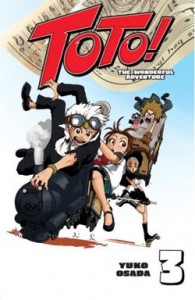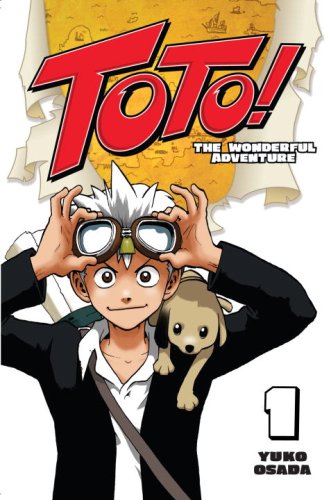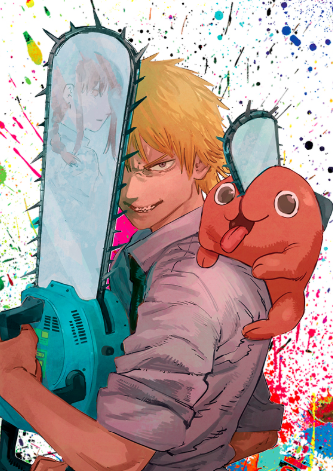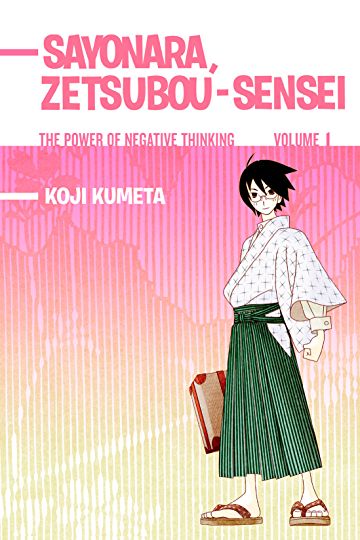If you’ve ever been to Canal Street in New York City — the Counterfeit Capital of North America — you know that there are two types of goods for sale there. The first are inept knock-offs: the “Cooch” purse with plastic handles, the “Rollex” with cubic zirconia insets and a flimsy metal band. The second are just as fake as the first, but are executed with enough panache that style-conscious women get a secret thrill in owning them: the plastic “Birkin” bag that looks like the real thing but costs $30, the canvas “Louis Vuitton” wallet that comes in prettier colors than the original.
The same principles apply to manga as well: there are series which shamelessly imitate a best-selling title like Dragonball or InuYasha, rehearsing the same plot without capturing the original’s charm, and there are copycats which bear a strong resemblance to the original but nonetheless work well on their own terms. Toto! The Wonderful Adventure falls into the latter category, a good-natured rip-off of One Piece and Rave Master that accomplishes in five volumes what many shonen series need twenty or thirty to pull off.
As one might guess from the title, Yuko Osada dresses up his swashbuckling treasure hunt with frequent allusions to Frank L. Baum’s The Wonderful Wizard of Oz. The hero, Kakashi (literally, “scarecrow”), is an orphan who dreams of leaving his small island home for grand adventures, but lacks the brains to realize his ambition. When a zeppelin makes an unscheduled stop on the island, he stows away, thus beginning an odyssey that loosely mirrors the plot of Baum’s novel. Kakashi finds a puppy in the ship’s cargo hold, then meets a feisty teen named Dorothy who attends St. Kansas Academy, practices “tornado” senjutsu (a martial art involving spinning kicks), and plans to visit Emerald City. As Kakashi and Dorothy follow the Yellow Brick Road — here played by an old railway line — they acquire traveling companions, each modeled on one of Baum’s iconic characters: Noil, a kind but cowardly soldier who aspires to be a comedian; Dam, a big, blustering army officer with a metal arm; and Paisley, the Northern Investigator for the W.I.T.C.H. organization.
 Central to the story is the relationship between Kakashi and Toto, the puppy he rescues in volume one. Though Toto initially appears benign, he has a big secret: his collar grants him the kind of amazing, destructive powers that make him of special interest to the military. It doesn’t take long before Kakashi and Dorothy find the Western army bearing down on them, anxious to reclaim their lost weapon.
Central to the story is the relationship between Kakashi and Toto, the puppy he rescues in volume one. Though Toto initially appears benign, he has a big secret: his collar grants him the kind of amazing, destructive powers that make him of special interest to the military. It doesn’t take long before Kakashi and Dorothy find the Western army bearing down on them, anxious to reclaim their lost weapon.
Though the story’s Oz jokes add novelty value, Toto! barks like a typical wacky shonen adventure, with lengthy set-pieces that follow the same basic formula: Kakashi et al. arrive in a town, befriend one of the locals, and narrowly evade capture by the army. Some of these story arcs are genuinely delightful; in volumes two and three, for example, Kakashi and Dorothy stumble into the once-glorious Dego City, a former railroad hub that’s been stripped bare by the Imperial Army in its never-ending quest for scrap metal. The heroes’ getaway is executed with a perfect mixture of suspense and humor, culminating in a scene that Miyazaki would be proud to include in one of his films. Other storylines feel more labored. In volumes four and five, for example, Kakashi and friends get swept up in a feud between rival gangs: Alice and the Wonder Family in one camp, the Uchiyaka (literally, “rabbit gun”) in the other. Osada piles on the Lewis Carroll references, double- and triple-crosses, and crazy shoot-outs, but the frenzied pace and frequent jump cuts render these chapters almost incoherent.
At times, Osada’s dogged capitulation to shonen formula invites not-so-flattering comparisons between Toto! and more popular series. He populates his story with a dim but determined hero (with a dead explorer father, no less), a feisty female sidekick, a comic-relief character with an outsized Afro, and a posse of villains-turned-allies — in this case, a group of sky pirates called the Man Chicken Family. Osada even provides a complex mythology to explain Toto’s power — something involving twelve directions and twelve “accessories” — that feels like a complete afterthought, an editor’s attempt to make Toto! behave more like One Piece or Rave Master.
Yet for all Kakashi’s earnest declarations about “family” and “adventure,” and all the wacky villains, epic battles, and amazing artifacts pilfered from One Piece and Rave Master, Toto! has undeniable charm. The characters have great rapport, for one thing; though their interactions follow the standard shonen model of friendly antagonism, their obvious loyalty to and affection for one another is contagious. The girls are on equal footing with the boys, for another; Dorothy and Paisley prove stalwart and resourceful, getting significant butt-kicking turns in the spotlight. The art is terrific, too; Osada’s crisp linework and vivid caricatures evoke Eiichiro Oda and Hiro Mashima’s styles without feeling slavishly derivative of either.
Best of all, Toto! is brief. By the time the series concludes, Kakashi has realized his life’s greatest goal: to see the world with friends. It’s not clear whether volume five was intended to be the final installment, or if the editors at Weekly Shonen Magazine canceled it prematurely; either way, Toto! The Wonderful Adventure is proof that a hero’s journey from ignorance to enlightenment needn’t take fifty volumes to convincingly achieve.
TOTO! THE WONDERFUL ADVENTURE, VOLS. 1-5 • BY YUKO OSADA • DEL REY • RATING: TEEN (13+)




badzphoto says:
I enjoyed reading Toto, but I felt that the end of book 5 was only the end of the traveling arc and not the story. I was wondering about Kakashi’s mysterious dad and other accessories… I guess I was hoping for more 🙂
CJ says:
I’ve been curious about this one, I mean, Bakegyamon worked pretty well as a 5 volume adventure series too, although I rather felt that it skipped some story arcs that I bet were in a longer anime, and even though it sounds like Toto kinda ends without it feeling like the true end of the series, I might still pick it up if I find it for cheap enough. I think I need some more adventure series to balance out my collection lately.
Katherine Dacey says:
@badzphoto: I agree that the ending feels a little ambiguous, as if the author had a few more story arcs planned. On the other hand, I was glad that the story wasn’t dragged out to epic lengths; too many good shonen series sink into mediocrity the longer they run. I’ve given up on dozens of series because they started to feel stale or repetitive (usually around the 15- or 20-volume mark).
@CJ: The five volumes of Toto! make a satisfying story, even though it lacks the grand closure of, say, Ranma 1/2. If your local library has a graphic novel collection (or belongs to an interlibrary loan program), you might find it that way.
Anonymous says:
I liked the imitation-goods/copied stories comparison. I wish I’d thought of that! This Toto sounds keen. Maybe I’ll take a look at it when I’m in the mood for a SJ title again. This definitely looks better than Dorothy of Oz.
Jade says:
I don’t remember the last volume actually wrapping anything up besides the Wonder Family arc. It was a really unsatisfying end for me, the cancellation must come with a week’s notice, or the author just didn’t care to tie up the loose ends.
I did like it though. After reading this, I gave Reborn a shot and found that to be an abomination that made me physically stupider for having read it. You’re definitely right about the severe lack of core originality, I think Osada thinks he can make anything a thin coat of his own style of paint. When I read a shonen book, I also expect a level of internal logic that I need to subscribe to, but Toto set that bar pretty high with all the ridiculous stuff going on book-ended by mafia-style syndicates portrayed as wacky good-natured shlubs who are still willing to murder random people with very real guns.
Katherine Dacey says:
@Anonymous: Thanks!
Are talking about the manhwa published by UDON? It’s nifty-looking, but incoherent. The references to Baum’s work are nearly as well integrated into the story as they are in Toto!. I reviewed the first volume at PopCultureShock a few years ago, if this is any help: http://www.popcultureshock.com/weekly-recon-111407/42900/#dorothy1.
@Jade: I didn’t realize Osada was the creator of Reborn!. I found that one too spazzy and ridiculous for my taste; I never got very far into the series.
As for the ending of Toto!, there’s one more story arc after the Wonder gang episode that answers one of the series’ biggest questions. I think Osada intended it to be the beginning of a new set of adventures for the characters, but it does work as an ending, too.
Jade says:
Durr, I’m sorry, Reborn! is by a completely different person. I do remember thinking it was the same artist when I picked it up, so I keep thinking it’s the same person.
I did a little more checking though and according to Italian wiki Toto’s five volumes were based on a two-volume series he did that were pretty successful. Most of Osada’s work seems to be shorter series, so as many loose ends are left hanging, I’m thinking he really did intend to finish it there..
Katherine Dacey says:
Thanks for the intel, Jade!
Anonymous says:
Yes, I meant the UDON series. The first volume WAS kinda fun, if not worth the 10 convention dollars I wasted on it, but then I borrowed the second volume from a friend, started reading, then stopped. And that was when I was still gleefully reading the Kingdom Hearts manga.
comicmonkey says:
Toto could not be imitating Fairy Tail, since it was published 4 years earlier.
Katherine Dacey says:
Ack! I’d confused Fairy Tail with Rave Master, which, in turn, predates Toto! by four years. Thanks for the catch.